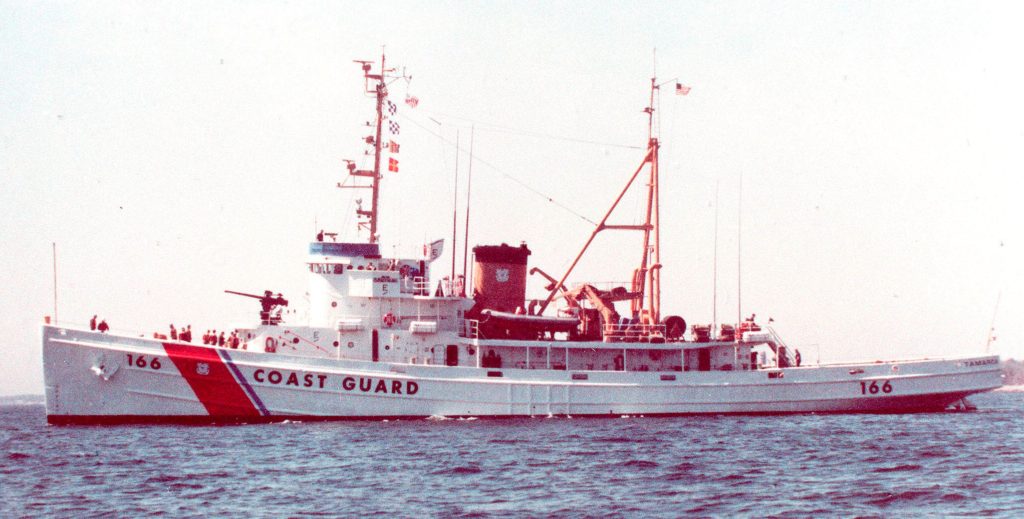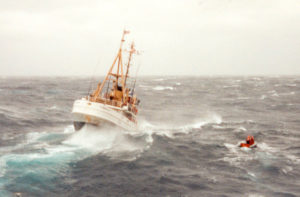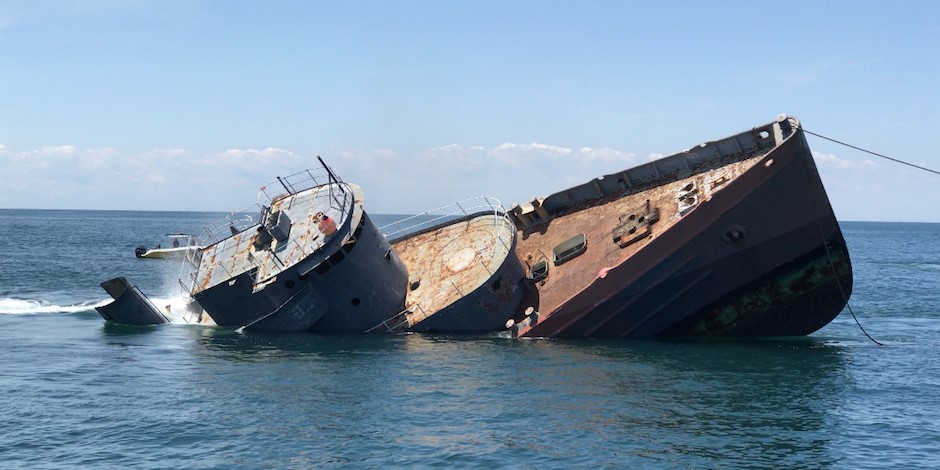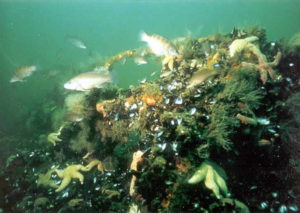December 16, 2020
DEP Milestone: It’s 2017, Coast Guard Cutter Is Scuttled to Forever Save Marine Life

The 1991 nor’easter lashed the East Coast. According to a National Park Service report, “coastal areas from Massachusetts to Puerto Rico experienced flooding and high winds, and beach erosion was severe and widespread. Hundreds of homes and businesses were knocked from their foundations. Sea walls, boardwalks, bulkheads and piers were reduced to rubble. Numerous small boats were sunk at their berths and thousands of lobster traps were destroyed. The Hudson, Hackensack, and Passaic rivers all experienced tidal flooding, and high winds brought down utility poles, power lines, tree limbs and signs.”
At top right, the USCGC Tamaroa is pictured in calm waters. The Coast Guard cutter, bottom photo, braves the elements during “The Perfect Storm” in 1991.
The storm, which raged from Oct. 28 to Nov. 2, also claimed 13 lives. Among those who died were the six crew members of the Andrea Gail, a fishing vessel that had been working in the North Atlantic Ocean, out of Gloucester, Mass. The story of the Andrea Gail and her crew was the basis of Sebastian Junger’s book, “The Perfect Storm,” and film adaptation of the same name.
The U.S. Coast Guard would rescue 25 people at sea during the height of the storm, including four of five members of a New York Air National Guard helicopter from the 106th Air Rescue Wing. The crew was forced to ditch its helicopter near Montauk, N.Y., after it ran out of fuel during a rescue effort.

The U.S. Coast Guard Cutter Tamaroa, which already had aided in the rescue of three people from a sailboat about 75 miles off Massachusetts’ Nantucket Island during the storm, then was dispatched to help the guardsmen. After four hours of slugging through roiling seas and battered by unrelenting wind and waves, the Tamaroa arrived near the downed airmen. The cutter’s 84-member crew labored for two hours to save the National Guardsmen, who already had spent six hours in the freezing waters. Four of the helicopter crew members were saved; a fifth, the crew’s pararescue jumper, was never found.
The National Park Service’s report quoted Weather Channel senior meteorologist Stu Ostro, who observed that “a non-tropical system absorbing a tropical one is not unprecedented, nor is a tropical cyclone developing from a non-tropical system. But for both processes to occur with the same system, not to mention one of this magnitude, is what made the cyclone so amazing. To me, this was the ultimate ‘hybrid’ storm.”
It was the perfect storm.
And now, a look at 2017 …
In 2017, the USCGC Tamaroa – a 205-foot Coast Guard cutter famously featured in Sebastian Junger’s 1997 book, “The Perfect Storm” – was scuttled off the coast of Cape May to become part of an artificial reef.

Started in 1984, New Jersey’s Artificial Reef Program provides marine habitat for many species of fish, shellfish and organisms that require hard substrate such as barnacles, sponges and soft corals. More than 100 defunct vessels have been sunk by the state for this purpose, though other objects also have been used, including New York subway cars, a giant horseshoe crab sculpture, military tanks and concrete “reef balls.” The Tamaroa, pictured at right above during its sinking, was one of the more well-known vessels to be repurposed in this way.
Originally commissioned as the USS Zuni in 1943, the ship served as a fleet ocean/salvage tug for the U.S. Navy and saw action in the Pacific Theatre, including at Iwo Jima, earning four battle stars for service during World War II. In 1946, the ship was transferred to the U.S. Coast Guard and renamed the Tamaroa, after a Native American tribe indigenous to the central Mississippi River Valley.

Between 1946 and 1994, the Tamaroa embarked on many law enforcement and fisheries protection operations, and performed oceanography, weather and international ice patrols. Over the years, the ship also participated in numerous search-and-rescue operations, including the 1991 rescue of four crewmen from a downed New York Air National Guard HH-60 helicopter immortalized in “The Perfect Storm” – a feat that earned the cutter and crew the Coast Guard Unit Commendation and the prestigious Coast Guard Foundation Award.
After a half-century of distinguished service, the Zuni/Tamaroa was decommissioned by the Coast Guard in 1994 and, on May 10, 2017, became part of the Del-Jersey-Land Inshore Reef – an artificial reef created with old military vessels, which also includes the 563-foot Navy Spruance-class destroyer, the USS Arthur W. Radford, the longest ship ever deployed to a reef in the Atlantic.
The Del-Jersey-Land reef is jointly managed by New Jersey, Delaware and Maryland, and is one of 17 artificial reef sites maintained by the DEP’s Bureau of Marine Fisheries to enhance recreational fishing and diving along the New Jersey Coast.
###
 OFFICIAL SITE OF THE STATE OF NEW JERSEY
OFFICIAL SITE OF THE STATE OF NEW JERSEY